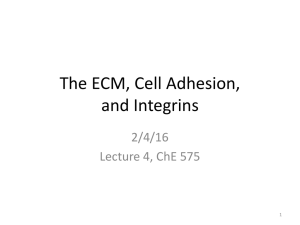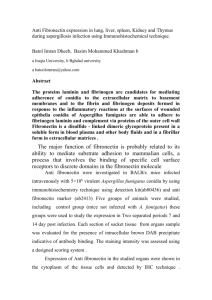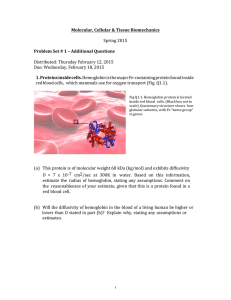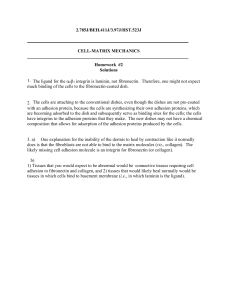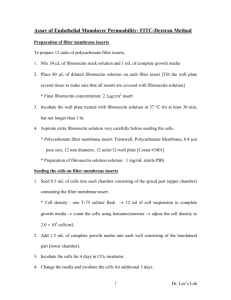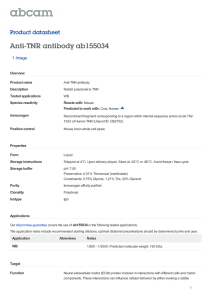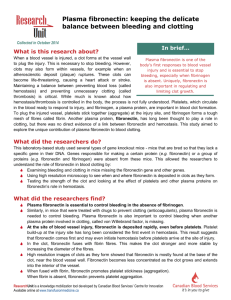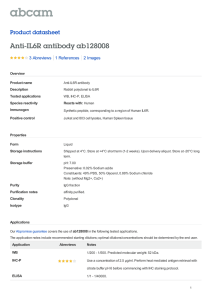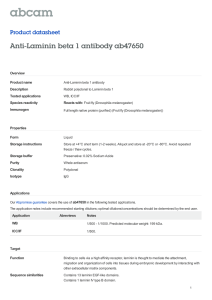CHAPTER 3 Cell - Matrix Interaction: Integrins and Fibronexus
advertisement
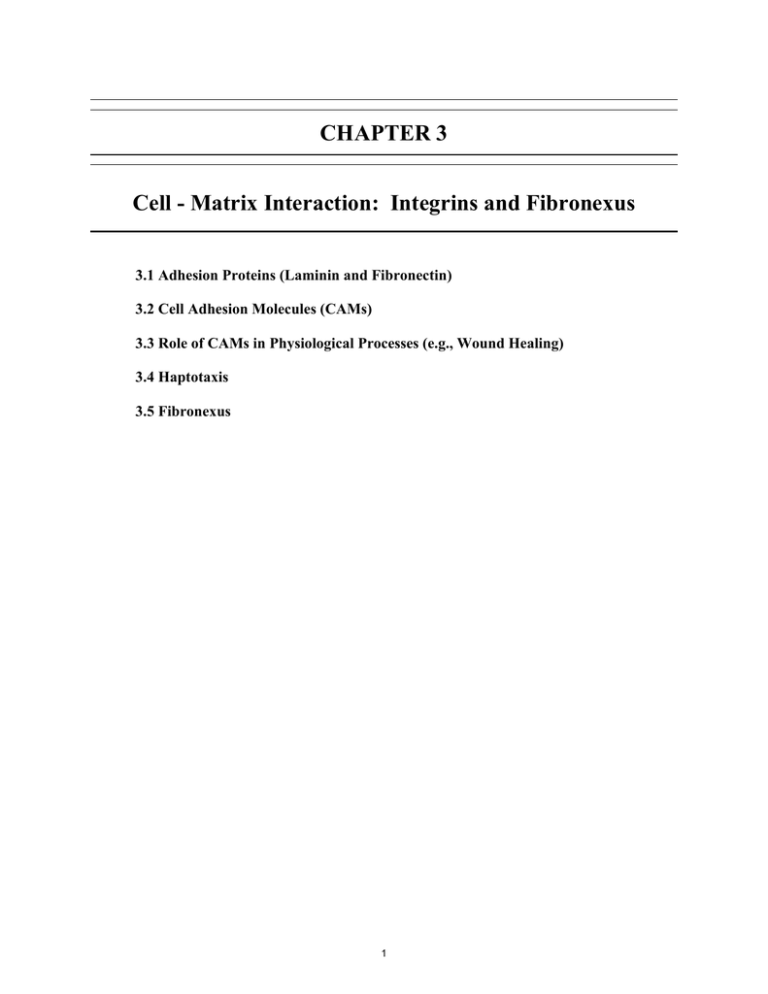
CHAPTER 3 Cell - Matrix Interaction: Integrins and Fibronexus 3.1 Adhesion Proteins (Laminin and Fibronectin) 3.2 Cell Adhesion Molecules (CAMs) 3.3 Role of CAMs in Physiological Processes (e.g., Wound Healing) 3.4 Haptotaxis 3.5 Fibronexus 1 3.1 ADHESION PROTEINS 3.1.1 Fibronecton 3.1.1.1 Functions depend on its binding to biological structures: cell surfaces, collagen, heparin, and fibrin. 3.1.1.2 Composed of two similar polypeptide chains (each with a molecular weight of 250 kD) linked by disulfide bonds. 3.1.1.3 Heterogeneity in the size of the fibronectin chains (from plasma and cell culture), but one gene. 3.1.1.4 The fibronectin molecule is a strand of independent, globular domains connected by short flexible segments (length is 140nm and diameter is 2nm). 3.1.1.5 Fibronectin binds to both hydrophobic and hydrophilic surfaces. 2 3.1.1 FIBRONECTON (Molecular Cell Biology, Darnell, et al., 1990) 3 Fibronectins Bind Many Cells to Fibrous Collagens and to Other Matrix Components Fibronectins are an important class of matrix glycoproteins. Their primary role is attaching cells to a variety of extracellular matrices (Figure 23-25)-all matrices, in fact, other than type IV (see Table 23-3). The presence of fibronectin on the surface of nontransformed cultured cells, and its absence on transformed (or tumorigenic) cells, first led to the identification of fibronectin as an adhesive protein. By their attachments, fibronectins regulate the shape of cells and the organization of the cytoskeleton; they are essential for many types of cell migrations and cellular differentiations during embryogenesis. F_ibronectins are also important for wound healing, for which they facilitate migration of macrophages and other immune cells into the affected area, and in the initiation of blood clots, by allowing platelets to adhere to damaged regions of blood vessels. Fibronectins are dimers of two similar peptides (Figure 23-26a); each chain is about 60-70 nm long and 2-3 nm thick. At least 20 different fibronectin chains have been identified, all of which are generated by alternative splicing of the RNA transcript of a single fibronectin gene. Analysis of proteolytic digests of fibronectin shows that the polypeptides consist of six tightly folded domains. Each domain, in turn, contains small repeated sequences whose similarities in amino aci d sequence allow them ro be classified into three types (Figure 23-26b ). Fibronectin possesses specific high-affinity binding sites for cell-surface receptors, collagen, fibrin, and sulfated proteoglycans. Further digestion of the cell-binding domain with proteases shows that a tetrapeptide sequence-Arg-Gly-Asp-Ser-within this domain is the minimal structure required for recognition by cells. When linked by covalent binding to an inert protein (such as albumin) and dried on a culture dish, this tetrapeptide is seen to be similar to intact fibronectin in its ability to promote adhesion of fibroblasts to the surface of the dish. . . . d d b d-fluorescing "' F1gure 23-25 F1bronectm, etecte Y a re b 3 antibody, is secreted by cultured f1.b ro bl asts, rev ealed . _ •,. 11 . . dy. F1"b ronecnn . form s a flbn yellow-fluorescmg annbo h arlis . f .th r e ce . array that is densest at the pomts o contact WI Courtesy R. 1-lynes. From R. 1-lynes 1986, c1.·Am · 254(6):42. s 4 L A M I N I N, FIB R 0 N E C T I N , A N D 0 T H E R M U L T I A D H E S I V E M A T R I X G L Y C 0 P R 0 T E I N S (a) N----------,----. C s s ' s s N ~"----- 60-70 c nm---~ Fibronectin dimer (b) Heparan su lfate Fibrin 12-3 nm ~ Figure 23-26 Structure of fibronectin and its variants. (a) Fibronectin contains two very simil ar pol ypeptides linked at their C-termini by two disulfide bonds. (b) Proteolytic digestion reveals six domains with specific binding sites for cell-surface receptors, hepara n sulfate proteoglycans, collagen, and also fibrin, a major constituent of blood clots. Note that there are two domains for binding to heparan sulfa te a nd two to fibrin , which differ in affinity. Each binding domain is composed of multiple copies of short repeating sequences, each of which may contribute to the binding. Each box represents a repeating sequence that is one of three types; each sequence is encoded by one or two exons. After R. H. Hynes et a/., 1989, Nectins and integrins: versatility in cell adhesion, in G. M . Edelman, B. Cunningham, and J.-P. Thiery, eds., Morphoregulatory Molecul es, Wiley, in press. Heparan sulfate Cell Collagen n ""'' "' 30,000 MW II 40,000 MW Repeating amino acid sequences: [j Type I -- Type II ~ Type Ill 923 Ill 65,000 MW IV 30,000 MW v 35,000 MW v1 3o,ooo Sequences sometimes present due to alternative splicing : ~· Fibronectin Promotes Cell Adhesion to the Substratum The fibroblast fibronectin receptor has been purified, cloned, and sequenced; it is a member of the integrin class of cell-surface receptors. On its external surface is a highaffinity binding site for the Arg-Gly-Asp-Ser cell-adhesion segment of fibronectin. Many cultured animal cells secrete fibronectin that binds to the culture dish and allows the cells to adhere to it. Fibronectin tends to concentrate at the small points where nonmigrating cells adhere to the substratum. Such · attached cells also contain abundant actin-rich stress fibers that maintain the cell's shape and attach to the plasma membrane where it adheres to substratum (Figure 23-27). Several actin-binding proteins such as vinculin (a) (b) )lo. Figure 23-27 (a) Immunofluorescence of a fixed, stationary cultured fibroblast showing colocalization of the fibronectin receptor (green) and actin-containing stress fibers (red). At the ends of the stress fibers, where the cells contact the substratum, there is coincidence of actin and the fibronectin receptor (yellow) . (b) Model of the connections be~ tween actin, fibronectin, and the extracellular matrix at the regions of contact between stationary fibroblasts and the substratum. The two-subunit transmembrane fibronectin receptor binds to fibronectin on its expolasmic side and talin 0 ? its cytoplasmic side. Vinculin binds to talin and probably ~ rirectly to an actin filament; fibronectin binds to fibrous col~gen and to many proteoglycans. Part (a) from ]. Duband et al., 1988,]. Cell Bioi. 107:1385. Collagen of extracellular matrix 5 s s I I ss coo - ..LLcoo­ MW 924 CHAPTER 23.,. MULTICELLULARITY: CELL-CELL AND CELL-MATRIX INTERACTiONs are also enriched in these regions. Electron micrographs occasionally reveal exterior fibronectin fiber bundles that appear continuous with bundles of actin fibers within the cell (Figure 23-28). As depicted in Figure 23-27, the fibronectin receptor may anchor both fibers to the opposite sides of the plasma membrane. The apparent continuity of matrix and cytoplasmic fibers is probably not coincidental. Many tumor cells growing in culture do not stick to plastic culture dishes. Such cells synthesize little fibronectin and contain few stress fibers. Adsorption of purified fibronectin to the culture dish frequently results in tight adhesion and, concomitantly, to the development of stress fibers. Cell exterior Fibronectin fibers Fibronectins Promote Cell Migration Fibronectins are abundant constituents of several types of extracellular matrices, generally together with fibrous collagens and specific proteoglycans (see Table 23-3). In many cases, these matrices are loosely packed with several fibrillar components secreted by various interstitial cells and provide trails along which other cells can migrate. An outstanding example is the migration of neuralcrest cells during an early stage of differentiation in all vertebrate embryos (Figure 23-29). Neural-crest cells arise from the ectoderm, or outer cell layer of the embryo, at the time when a region of the ectoderm rolls up inward and forms the neural tube that will generate the spinal cord neurons. The neural-crest cells migrate from the dorsal edge of the neural tube to all regions of the embryo. Those that move along the ventromedial pathway eventually stop and form aggregates that differentiate into various nerve ganglia or into the adrenal medulla. Attachment of migrating cells to fibronectin is essential for cell migration, and it is thought that matrix fibers containing fibronectin provide "tracks" along which the cells move. As evidence for this, microinjection into the embryo of an antibody specific for the cellsurface fibronectin receptor blocks migration. Injection into the embryo of a small peptide that contains the ArgGiy-Asp-Ser binding domain of fibronectin also blocks migration of neural-crest cells. Apparently the peptide binds to cell-surface fibronectin receptors and prevents receptors from binding to matrix fibronectin. In contrast to embryonic cells, cells in an adult organism generally do not migrate. An exception is woundhealing, when many fibroblasts and immune-system cells, including macrophages, migrate into the affected area. These cells move across blood clots, which are composed primarily of the fibrous protein fibrin. Fibronectin is incorporated into the clot as it forms by virtue of its fibrinbinding domains (see Figure 23-26); fibroblasts, in turn, adhere to the fibronectin as they migrate across the clot. A cell such as a fibroblast that contains a single type of fibronectin receptor can regulate its mobility. Fibroblasts migrating on fibronectin make and break contacts with Plasma membrane Actin­ containing 7-nm microfilaments A Figure 23-28 Electron micrograph of the junction of fibronectin and actin fibers in a cultured fibroblast. Individual actin-containing 7-nm microfilaments, components of a stress fiber, traverse the obliquely sectioned cell membrane. The microfilaments appear in close proximity to the thicker, densely stained fibronectin fibers on the outside of the cell. Courtesy of I.]. Singer. Copyright, 1978, M.I.T. the matrix. In such cells the fibronectin receptor is laterally mobile in the plasma membrane, as determined by fluorescence recovery from photobleach experiments (see Figure 13-25). As the cells stop migrating and form stress fibers, the fibronectin receptors become immobilized at the sites in contact with substratum and keep the cells tightly bound to the matrix; immobilization may be due to binding of the receptor, via talin and vinculin, to the actin cytoskeleton (see Figure 23-27). Emerging from studies of the cytoskeleton, plasma membrane, matrix receptor proteins, and extracellularmatrix components is a picture of a continuum of interactions between the elements that allows for coordinated activities. 6 3.1.2 LAMININ (Molecular Cell Biology, Darnell, et al., 1990) 7 (a) Laminin Is a Principal Structural Protein of All Basal Lamina All basal laminae contain a common set of proteins and glycosaminoglycans: type IV collagen, heparan sulfate proteoglycans, the poorly understood glycoprotein entactin, and laminin. The basal lamina is often called the type IV matrix, named after its collagen component (Table 23-3). All of the matrix components are synthesized by cells th,at rest on the basal lamina. Laminin is a cross-shaped molecule almost 70 nm long (Figure 23-22); it is as long as the basal lamina is thick. It contains three polypeptides of total molecular weight 820,000 and has high-affinity binding sites for other components of the basal lamina. ..,.. Figure 23-22 The structure of laminin. (a) An electron micrograph of laminin, dried on a grid and shadowed with platinum, shows it to be a cross-shaped molecule. (b) A diagram. [Part (a) see]. Engel et al., 1981, ]. Mol. Bioi. 150:97.] Part (a) courtesy of]. Engel, E. Odermatt, A. Engel,]. Madri, H. Furthmayer, H. Rodhe, and R. Timpl. Part (b) after G. R. Martin and R. Timpl, 1987, Ann. Rev. Cell Bioi. 3:57-85. (b) Binds to surface receptors on many cells Type-IV collagen binding site ~ ___j a-Helical coiled-coil t~ Binds surface receptors } on neuntes IE >I Heparan sulfate proteoglycan } binding site 25 nm Laminin 8 Table 23-3 Representative matrix types produced by vertebrate cells in vivo Associated anchorage protein Type I Fibronectin Type II Type III Fibronectin Fibronectin Type IV Laminin Type V Fibronectin Type VI Fibronectin SOURCE: Associated proteoglycans Cell-surface receptor Chondroitin sulfate Dermatan sulfate Chondroitin sulfate Heparan sulfate Heparin Heparan sulfate Heparin Heparan sulfate Heparin Heparan sulfate Integrin Fibroblasts Integrin Integrin Laminin receptors lntegrin Chondrocytes (cartilage) Quiescent (nondividing) hepatocytes; fibroblasts in association with epithelia ' All epithelial cells; endothelial (blood-vessel lining) cells; regenerating hepatocytes Quiescent fibrob lasts Integrin Quiescent fibroblasts L. M. Reid, 1989, in] . W. Pollard and J. M. Walker, eds., Methods in Molecular Biology, Vol. V: Tissue Culture, Humana. Cells generally do not bind directly to type IV collagen or to matrix proteoglycans. Rather, laminin anchors the basal lamina to the cell surface. Different cells that are surrounded by a basal lamina such as epithelial cells, fat cells, and smooth and striated muscle may utilize different cell-surface receptor molecules. There are at least two different regions of the laminin molecule to which these receptors bind. Directed by growth cones, axon and dendrite projections of nerve cells (neurites) often elongate, migrating along extracellular-matrix pathways that contain laminin. Laminin receptors in the growth cones bind to laminin in such a way that interactions form and break readily as the neurite moves along the fiber. In fact, when neurites are placed on a film of laminin dried on a plastic surface, the cells extend axonlike processes. Thus, it is thought that laminin exerts a hormonelike action on the neurites and that the neurite laminin receptor transduces the laminin signal across the plasma membrane, as hormone receptors do. 9 The basal lamina is structured differently in different tissues: different laminin receptors on different cells may generate this diversity. For instance, the basal lamina that surrounds capillary cells forms a filter that regulates passage of proteins and other molecules from the blood into the tissues; similarly, the double-thickness basal lamina in the glomerulus acts as a filter in forming the urine (Figure 23-24). In smooth muscle, on the other hand, the basal lamina connects adjacent cells and maintains the integrity of the tissue. Laminin and other type IV matrix components are also found in mammalian four- and eight-celled embryos; the basal lamina helps these cells adhere together in a ball. Urinary Basal lamina Capillary endothelial cell Fenestrations I 0.5Jlm Capillary 1 ....---...JJ lumen A Figure 23-24 Electron micrograph of a section through a rat kidney glomerulus, showing how the basal lamina am to filter capillary blood, forming a filtrate in the urinary space that ultimately becomes urine. The endotheiial cells that line the capillaries have many gaps within them, as do the epithelial cells that line the urinary space, so that the basal lamina is exposed to both the blood and urine spaces. The basal lamina in this region is a fusion of two basal lami· nae, one formed by the endothelial and one by the epithelial cells, and is twice as thick as basal lamina in most other tis· sues. From R. Kessel and R . Kardon, 1979, Tissues and Or· gans: A Text-Atlas of Scanning Electron Microscopy, Free· man, p. 233. 10 3.4 HAPTOTAXIS from Sports Induced Inflammation (eds. W.B. Leadbetter, et al., 1990) Cell Migration in Repair Wound repair requires the orderly accumulation of both cells and matrix. The interaction of extracellular matrix and cells is critical to the migration ofthe cell types in the area ofinjury. Soluble chemotactic factors attract cells to the wound· site, and signals in the insoluble matrix direct the distribution of these cells. Haptotaxis is the migration of cells along an adhesion gradient on a substratum. 144 During haptotaxis, cells randomly. extend processes in all directions; those that reach a proper substratum (Fig. 13) adhere to it and spread, preventing other processes from adhering. The binding Fig. 13 Haptotaxis. Haptotaxis is the migration ofcells along an adhesion gradient on a substratum. of the plasmalemma to a specific extracellular matrix component creates an anchor for other cells. The unattached portions of the membran~ form new processes and help create a new advancing edge. Dependmg on the cell type, extracellular matrix components such as fibronectin and Jaminin can enhance haptotaxisY·•6o 11 MIT OpenCourseWare http://ocw.mit.edu 2.785J / 3.97J / 20.411J Cell-Matrix Mechanics Fall 2014 For information about citing these materials or our Terms of Use, visit: http://ocw.mit.edu/terms.
